By Sapphire McMullan-Fisher, Michael Amor and Shari Bamos
Tea-tree Fingers (TTF, Hypocreopsis amplectens) is listed as Critically Endangered on the International Union for the Conservation of Nature Red List and the Flora and Fauna Guarantee Act, Victoria. We discovered a population on French Island in 2021 while working with Royal Botanic Gardens Victoria (RBGV) staff and volunteers. French Island represents the species stronghold, being the only known population within a protected National Park. Our exciting discovery has already influenced land management and planned burning practices in areas surrounding known populations.
In partnership with RBGV and Zoos Victoria, we carried out a project for the Parks Victoria Volunteering Innovation Fund Investigating the extent of Australia’s rarest fungus on French Island.
Our project aimed to train existing and newly engaged volunteers in best-practice threatened fungi surveys and to extensively search French Island to determine the extent and abundance of TTF. We also aimed to better understand the post-fire presence/absence of TTF.
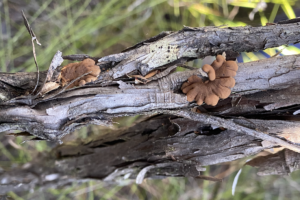
Fresh sporebodies of the critically endangered Tea-tree Fingers on Tea-tree branches on French Island September 2023 (image credit: SJM McMullan-Fisher)
Most known populations were monitored, and additional areas (burned and unburned since 1983-4) were searched to expand the known populations. Volunteers searched through thick heathy woodlands for this elusive fungus. We successfully extended known populations at French Island and Grantville (mainland). New populations were found on French Island and at Adams Creek Nature Conservation Reserve. We still have not looked for TTF in all likely habitats near known populations as this is tricky, time consuming work. We are grateful to all the volunteers who came out to help look for TTF as part of this project.
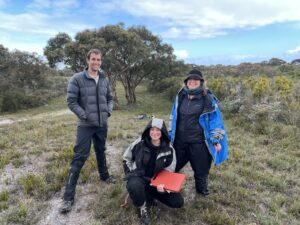
TTF Team leaders were Michael Amor, Shari Bamos and Sapphire McMullan-Fisher, seen here on French Island (image credit: Kay Treloar, Friends of French Island)
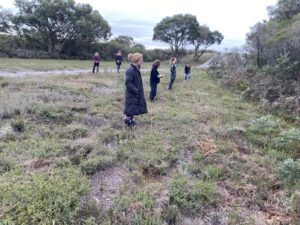
Volunteers using transect searching on French Island (image credit: SJM McMullan-Fisher)
Data has been shared with the VBA allowing land managers access to the locations. This is particularly important as this is where Parks Victoria and other agencies get their data for their fire management. Some of the finds on French Island that were in long unburnt areas (not burnt since 1984) were due for planned burning this coming season. These burns have been delayed a year so they can plan how to best protect known populations. We are hoping they will consider using water to dampen known sites to prevent population patches burning during planned burns. We don’t recommend the traditional protection of physically clearing around sensitive populations as we think there are problems with dispersal and drying out of habitat. Perhaps wetting down populations would be a less disturbing way to prepare for planned burns. Fire is a necessary part of management so balancing the needs of human safety and multiple species (including threatened species) is important.
Keen community members and groups at both Friends of French Island and Save the Western Port Woodlands have begun monitoring some of their TTF individual branches over time. We hope to have an online training session at the start of the fungi season next year to help people get back into fungi mode. We are concerned how populations will survive under drier El Niño weather patterns. The images below show how quickly the reproductive tissue dries out with just a week of dry weather.
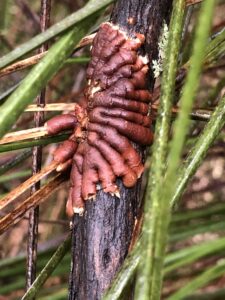
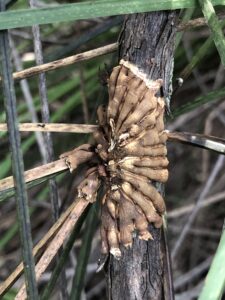
The same reproductive TTF at Granville, the left shown plump and moist on 23 Aug 2023 and just 6 days later on the right it has shrunk and looks dry (image credit: Jon Temby)
We have updated the TTF identification and monitoring booklet. This shares the latest tips about how to record data on both plant and fungi hosts. TTF has multiple hosts as it is a mycoparasite so lives off a rotting fungus which is called Hymenochaete, which lives off plants. The preferred plant hosts are mostly woody species of Prickly Tea-tree (Leptospermum continentale), Silky or Heath Tea-tree (L. myrsinoides), Yarra Burgan (Kunzea leptospermoides), Prickly Broom-heath (Monotoca scoparia), and Scented Paperbark (Melaleuca squarrosa). It is sometimes found on Spike Beardheath (Leucopogon australis), Sheoaks (Allocasuarina spp.), and Silver Banksia (Banksia marginata), and opportunistically scrambles on nearby reeds, rushes and sedges. This year saw the first few records of TTF and its host fungi on living and dead Austral bracken (Pteridium esculentum), and this trip it was also found on twigs of Messmate Stringybark (Eucalyptus obliqua).
Interestingly Shari managed to take a shot that looks like the host tissue on the basal pad of some TTF fingers. We still have lots to learn about how these two fungi interact.
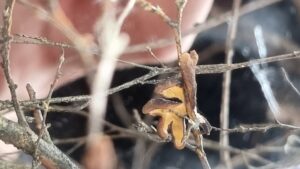
TTF from Nyora with likely brown host tissue behind the TTF fingers tissue shown reflected in mirror (image credit: S Bamos)
We have been observing that Hymenochaete often has binding mycelium, which is helping those keen-eyed searchers know that they are in likely TTF habitat. As Shari said “When you see host binding mycelium, slow down and keep looking”.
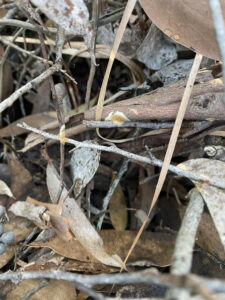
Binding mycelium of the TTF host fungus Hymenochaete, this ochre brown to cream coloured tissue often binds branches and other litter together (image credit: SJM McMullan-Fisher)
Another trick to finding TTF is learning how to recognise a look-alike, a relative and namesake called Hypocrea. This is the sexual form of a common mycoparasite Trichoderma. This has more cushion shapes than fingers and the asci don’t form bumps like those seen on TTF mature specimens.
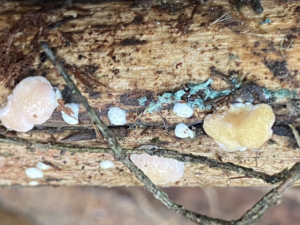
Hypocrea is a TTF look-alike that has been observed several times in TTF habitat (image credit: SJM McMullan-Fisher)
We hope to continue learning more about TTF, its hosts and habitat, to better conserve this critically endangered species. If you would like to help us, please contact Sapphire by emailing fungimapconservation@gmail.com.

